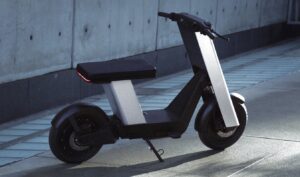In the quietly humming chorus of electric mobility, a new tone reverberates from Brooklyn’s industrial design circles. Infinite Machine, a studio that positions itself at the intersection of intelligent hardware and urban sensibility, has introduced a new chapter in micromobility with the Olto—an e-bike engineered not merely for motion, but for meaning. It is a sculptural machine born of aluminum, modularity, and restraint, offering riders more than a way to commute. It offers a statement.
What first emerges as peculiar in Olto’s silhouette—a muscular linear frame, square saddle, and compact body—quickly reveals itself as genius through interaction. The visual simplicity masks a dense layering of engineering forethought. Beneath its clean architectural lines and deliberate sparseness lives a vehicle that is both appliance and artifact, something equally suited for city commutes and impromptu design exhibitions. It is at once functional transport and a collector’s object-in-motion.
Sculptural Form, Engineered Simplicity
Crafted with a lightweight aluminum body, the Olto exudes structural confidence without succumbing to bulk. It does not pretend to hide its materials—the brushed texture of the metal, the precise seam work, the clean welding lines, all reveal a reverence for industrial honesty. It is raw and real, like a loft stripped of its drywall. The frame sits low and forward, almost recalling the blueprint of a scooter from a distance. But despite that suggestion, the Olto remains unmistakably a bike—legal on bike lanes, nimble enough for pedestrian pathways, light enough to lift when necessary.
The frame curves only where it must: a slight taper along the back near the footpegs, which remain hidden until needed, and a modest arc under the seat to cradle the swappable battery compartment. There are no gratuitous lines, no ornamental flourishes. The Olto carries the kind of discipline found in Bauhaus-inspired furniture, where every component serves both form and function.
Foldable Pedals & Footpegs: Hidden Mobility Aids
One of Olto’s most remarkable design decisions is its magnetic foldable pedals, which snap flush against the frame when not in use. These aren’t the rickety foldables found on budget bikes; they’re machined precisely and seat into sculpted recesses via magnetic retention. They create a monolithic silhouette when folded in, keeping the lines pure and uncluttered.
For passengers, retractable footpegs glide out from under the main frame. Unlike after-market add-ons or protruding pegs that might catch on a doorway or a pant leg, these disappear entirely when not in use. There’s a subtle sense of choreography in the act of pulling them out—like drawing a blade from a sheath—fluid and mechanical at once.
The Square Seat: Spatial Rethinking of Comfort
Atop the structure sits a square-shaped seat, a departure from traditional elongated or ovular designs. This squared silhouette doesn’t just reinforce Olto’s geometric identity—it provides broader coverage and firmer support, particularly for dual riders. The squared proportions distribute weight evenly and allow for a natural split between rider and passenger, without requiring a significant frame extension or additional hardware.
Its compact generosity is accented by underseat handles, which double as grab rails for passengers and tie-down points for small cargo. These angular, integrated loops are neither intrusive nor ornamental—they subtly emerge from the seat’s base like scaffolding from a structure.
The seat also hides a clever secret: lift it upward and you reveal the swappable battery, a boxy unit engineered for rapid replacement. Riders with limited access to charging infrastructure can carry an extra pack and hot-swap as needed. No wires, no tools—just a grip and a lift.
Headlamp Geometry & Light Integration
Lighting on the Olto is both futuristic and functional. The headlamp cluster sits low on the front frame, positioned just above the tire. This inverted location allows for dual visibility in fog or city rain, creating a more grounded beam angle while minimizing glare for oncoming pedestrians. Its high and low beams operate autonomously or manually, shifting depending on light environment and speed, much like automotive smart lighting systems.
The lighting is framed within a thin matte housing—again minimal, again architectural. Around the perimeter of the frame, thin reflective pinstripes offer passive nighttime visibility without disrupting the clean chassis with loud hi-vis graphics.
Modularity & Personal Adaptation
What elevates Olto beyond its aesthetic values is its deeply modular framework. Unlike many electric two-wheelers that require brand-specific accessories or convoluted mounting systems, Olto is designed to be modified and expanded by the rider. At launch, Infinite Machine has made available a set of options:
- Rear rack for courier-style storage
- Front basket for casual errands or farmer’s market hauls
- Child carrier integrated with a frame lock-in system
- Center panel attachments for enclosed cargo or tools
Each module snaps or bolts into discreet anchor points along the frame. There is no need to drill or clamp—everything mounts flush and maintains the overall design language. The bike adapts from solo commuter to two-person shuttle, from delivery tool to family vehicle, without ever breaking its composure.
Automatic Locking System
Perhaps the most utilitarian—and underrated—feature is the automatic locking mechanism. The Olto does not rely solely on external locks. Its internal auto-lock immobilizes the rear motor wheel and sends an alert to the user’s app if tampered with. The system senses motion after being parked, and unless unlocked via biometric or app control, it locks the drive train.
In a world plagued by bike theft in dense urban centers, this digital-mechanical hybrid of movement detection, immobilization, and notification is less a gimmick than a requirement. Olto acknowledges the reality of urban mobility and designs against it—not around it.
Ride Dynamics & Electric Assistance
The electric motor is tuned for urban responsiveness rather than top-speed sprints. It thrives in short acceleration bursts, seamless hill climbs, and adaptive braking. Whether accelerating from a crosswalk or weaving through gridlock, the Olto responds like a silent feline—agile, aware, and always balanced.
But the motor is not tyrannical. For those who wish to return to analog movement, the Olto offers manual pedal engagement. The transition is smooth—riders can swivel the pedals into place mid-ride and continue manually, whether for fitness, range extension, or simply the pleasure of propulsion. The drivetrain supports pedal-assist as well, integrating the motor’s torque only when needed.
Urban Philosophy Encapsulated in a Frame
Infinite Machine didn’t design the Olto for the masses—they designed it for those who consider transportation as an extension of self. It’s a vehicle for the architect, the musician, the coder, the florist—the creatives and the careful. It doesn’t shout its purpose. It fulfills it quietly, beautifully.
In cities increasingly dominated by soulless rideshare scooters and dockless rental fleets, the Olto presents a refreshing paradox: a machine both intimate and shareable, both private and public in its utility. It can serve one or carry two, all while holding groceries and keeping a phone charged via its USB-C port tucked under the seat.
And as much as it moves, the Olto also stands still with purpose. Parked, it remains an object of admiration. A stationary presence that suggests movement. A line waiting to be drawn.
Flow
The Infinite Machine Olto e-bike is not a revolution by brute force—it is a revolution by design discipline. It doesn’t chase trends. It refines function. Every line, every bracket, every invisible fold is considered. The bike invites riders into a slower awareness of their commute—not just how they move, but why.
In Olto, movement becomes an artistic gesture. It’s as much a vessel for physical travel as it is for spatial experience. Whether navigating Brooklyn’s cobblestones, the alleyways of Shibuya, or Berlin’s brutalist corridors, Olto becomes an extension of the user’s values—clean, minimal, unintrusive, and unapologetically modern.
To ride it is not just to commute—it is to participate in a future imagined not through speed or power, but through clarity.
No comments yet.









